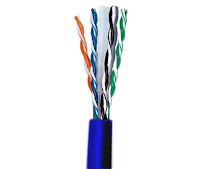Networking cables are often use for connecting one device to some other networking devices which are placed at some distance may be printers or scanners etc. We use them for different purposes.
Network cables are of different types depending upon their networks topology, Protocol, and size. Some people use wireless which somehow decreases the importance of network cables. There are three main types of networking cables which are coaxial wire, Optical Fiber wire, and Twisted Pair cable.
Twisted Pair cable:-In this kind of cables there are pair of wires which are twisted around each other and the purpose of that is to cancel out electromagnetic interference (EMI) of other wire pairs and from other external sources. This cable is often used at home or for some Ethernet networks. There are three different types of twisted pair of cables which are shielded, unshielded, and foil.
Untwisted pair cable:-It is the opponent of twisted pair cables in twisted cable there is a pair of cable which is twisted around each other but in untwisted pair cable there is a whole different story in this there is also a pair of wire present like in twisted pair wires but they are not twisted to each other they are parallel to each other they move head to head. They are also used for home purposes but twisted are more often used and these wires are rarely used.
Fiber Cable:-In this of cable there is a center glass core which is surrounded by several layers of protective material. There as an insulating jacket which is made of fire resistant materials Teflon or PVC.
It is expensive than other cables and it transfers data to longer distances.
Coaxial Cables:- These are often used for the television. It is mainly used to transmit signal.
Networking cables are really a great invention because of them we can transfer our data to different devices placed far. They are really useful in places like hospitals, Educational Centers and mainly in offices. Networking cables are necessary in almost every electrical phenomenon.
We use these cables often in our daily life you can see at home we connect our computer to modem by using networking cables. It became the necessity of networking thing and it is the one of the most important inventions of all time. There are different cables available in the market you can order them by keeping in mind that for which purpose you are using it.
There are three major types of coaxial wires.
RegardsNetwork cables are of different types depending upon their networks topology, Protocol, and size. Some people use wireless which somehow decreases the importance of network cables. There are three main types of networking cables which are coaxial wire, Optical Fiber wire, and Twisted Pair cable.
Twisted Pair cable:-In this kind of cables there are pair of wires which are twisted around each other and the purpose of that is to cancel out electromagnetic interference (EMI) of other wire pairs and from other external sources. This cable is often used at home or for some Ethernet networks. There are three different types of twisted pair of cables which are shielded, unshielded, and foil.
Untwisted pair cable:-It is the opponent of twisted pair cables in twisted cable there is a pair of cable which is twisted around each other but in untwisted pair cable there is a whole different story in this there is also a pair of wire present like in twisted pair wires but they are not twisted to each other they are parallel to each other they move head to head. They are also used for home purposes but twisted are more often used and these wires are rarely used.
Fiber Cable:-In this of cable there is a center glass core which is surrounded by several layers of protective material. There as an insulating jacket which is made of fire resistant materials Teflon or PVC.
It is expensive than other cables and it transfers data to longer distances.
Coaxial Cables:- These are often used for the television. It is mainly used to transmit signal.
Networking cables are really a great invention because of them we can transfer our data to different devices placed far. They are really useful in places like hospitals, Educational Centers and mainly in offices. Networking cables are necessary in almost every electrical phenomenon.
We use these cables often in our daily life you can see at home we connect our computer to modem by using networking cables. It became the necessity of networking thing and it is the one of the most important inventions of all time. There are different cables available in the market you can order them by keeping in mind that for which purpose you are using it.
There are three major types of coaxial wires.
- Rg6 Coaxial wire
- Rg11 Coaxial wire
- Rg59 Coaxial wire
Steve Daniel,
310 S Milpitas Blvd, Milpitas, CA 95035
PH: +1(408) 844-4934
http://www.1000ftcables.com





















